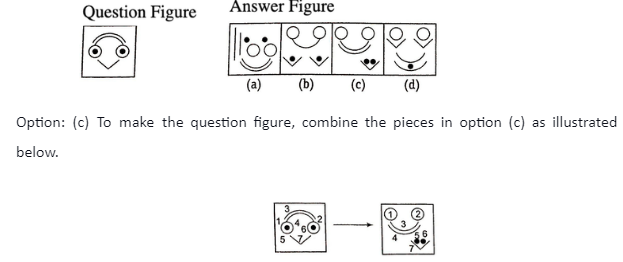A specific geometrical figure made up of elements of various designs is described as a figure formation. Constructing geometric shapes like triangles, squares, circles, and so on from a collection of components with varying patterns focuses on this area of nonverbal reasoning. In addition, other figure questions can be linked to provide an alternate answer figure, and the correct answer must be chosen among those.
Definition Of Figure Counting
Formation of Figure is a term used to describe the process of constructing a specific geometrical shape using a number of various pieces.
Figure counting is forming a defined geometric figure using parts of various designs. On the other hand, images are classified into many types, such as mirror images, water images, and so on. In the case of a mirror image, when an object is put near it, the image or reflection of that object appears in the mirror.
A water image is an object’s reflection in the water. It is the image of an object that has been turned upside down and has been inverted vertically. When positioned horizontally in the figure, the water image of all forms looks like the figure’s mirror reflection. Numerous problems based on the counting figures reasoning part are included in multiple government competitive exams.
Different Types of Figure Formation
Several types of questions on figure formation are asked in competitive exams. We have grouped these into numerous categories based on their variety.
- Based on Figure Arrangement
- Based on the use of symbols and signs
- Based on the Triangle’s Formation
- Square Formation with Figures
1: Based on Figure Arrangement
In these figure questions, the student must choose an answer choice figure that can be made by arranging the parts in the question figure.
Example

Based On the Use of Symbols and Signs
This form of question requires the student to assemble a question figure from a fragment of one of the answer choices and then figure out which of those figures is the correct one. While elements of the question figure’s boundary lines appear in the answer figure, they are considered when constructing the question figure. These inquiries necessitate an in-depth examination of the data in the questions and answers.
Example

Square Formation with Figures
A triangle (equilateral, isosceles, etc.) is formed in this form of a question by uniting three figures from a group of figures of varying designs. The student must determine the proper arrangement of figures from various combinations provided.
There is no set rule or method for resolving these kinds of questions. Instead, these questions necessitate a thorough examination of the different elements (designs) that combine to form a figure and a spatial assessment of the shape to be formed.

Option: (c) An equilateral triangle has an angle of 60º on each side, and the lengths of all three of its sides are also equal. Now that we cannot precisely measure the angle and sides, we must make close approximations to these measurements and values. Keeping these ideas in mind, we start by combining figures E and C, which will appear as follows.

Square Formation Using a Set of Figures
These questions ask you to connect three different shapes to form a square, and you’ll need to know how to do so. Then, the student must select the combination of the correct figure from the given options.

Option: (c). Only figure (C) has a right angle. Figure (B) will resemble the following figure if paired with figure (X).

Counting of Figures
Figure counting is the derivation of basic geometric plane figures from complex figures. You have a figure or a shape when counting figures. You must recognise a known shape from the specified shape and count how many times it appears in the particular shape.
Straight lines, triangles, squares, rectangles, and polygons are all examples of figures that may be counted. To correctly answer these figure questions, a student must first find the requisite figures formed by different segments of the original figure, then the relevant figures created by two figures combined, and so on.
The following are the various types:
- Straight Lines and Triangles Counting
- Quadrilaterals and Polygons Counting
- Circles and Colours Counting
Grouping of Figures
These questions give you a collection of numerical figures, commonly 6, 7, or 9.
The student must categorise the figures into groups of figures with similar properties. Finally, the best answer is chosen from reasonably close alternatives.
Conclusion
In figure formation questions, the number of components used to construct the figure must be identical to the collection of elements in the solution figure. This enables you to eliminate specific selection figures quickly. A figure’s parts may be of different sizes, but the shapes must be the same no matter how large or small the components are.
 Profile
Profile Settings
Settings Refer your friends
Refer your friends Sign out
Sign out




